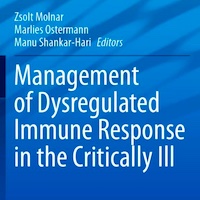Tag: SIRS
ICU-acquired Weakness: Critical Illness Myopathy and Polyneuropathy
Critical illness myopathy (CIM) and critical illness polyneuropathy (CIP) are significant complications in intensive care unit (ICU) patients, first identified in the late 20th century. These conditions often present... read more
Association Between Early Ondansetron Use and Sepsis Risk in ICU Patients
In both patients with SOFA 3, early ondansetron use was correlated with a reduced risk of sepsis. Patients with early ondansetron use had lower odds of experiencing sepsis than patients without early ondansetron use, which... read more
Code Sepsis – Early Decompensation and Predictors
Early recognition and management of sepsis within the first hour of a sepsis alert is critical for patient survival, requiring healthcare providers to be trained to identify "red flag" symptoms like rapid breathing (tachypnea)... read more
Predicting Sepsis Outcomes – Efficacy of Early Warning Scores
In resource-limited settings, NEWS proved to be the most effective tool for early risk stratification in sepsis patients. Its adoption could significantly enhance sepsis management and improve outcomes in emergency departments... read more
Prognostic Value of Composite Inflammatory Markers in COPD Patients
Elevated systemic immune inflammation index (SII), systemic inflammatory response index (SIRI), pan-immune inflammation value (PIV), neutrophil-to-lymphocyte ratio (NLR), and platelet-to-lymphocyte ratio (PLR) are associated... read more
Developing a Rapid Screening Tool for High-risk ICU Sepsis Patients
This study demonstrates that machine learning-based prediction models for sepsis can enhance clinical outcomes through accurate risk assessment during the critical first 24h of ICU admission. Despite healthcare system... read more
Lymphocyte Count Trajectories Associated with Prognosis of Sepsis Patients
Three distinct lymphocyte trajectories were identified in sepsis patients using GBTM. Trajectory 3 was a strong predictor of 7-day and 28-day mortality, while Trajectory 1 was associated with early death. These findings... read more
Management of Dysregulated Immune Response in the Critically Ill
This book, part of the European Society of Intensive Care Medicine (ESICM) textbook series, deals with dysregulated host response a relatively new term introduced by the Sepsis-3 definitions in 2016. In contrast to systemic... read more

Prediction Model for Safe Early Discharge of Patients with an Infection
By combining readily available parameters, we developed and internally validated a prediction model for safe, early discharge among patients. Further research, preferably in a multi-center setting, is warranted to externally... read more
Screening Tools for Sepsis Identification
The authors undertook a rapid review to determine the suitability of sepsis screening tools in the emergency setting with regard to sensitivity and specificity of sepsis diagnosis. The review recognized that there is currently... read more
Sepsis Prediction Model for Determining Sepsis vs. SIRS, qSOFA, and SOFA
In this cohort study of 60,507 hospital admissions, we found that although the SPM marginally outperformed existing prediction scores in balanced accuracy for classification of sepsis, it suffers from poor timeliness, limiting... read more
Albumin Infusion May Decrease the Mortality of Hypoalbuminemia Patients with Severe Acute Pancreatitis
Our study revealed that the lowest albumin level within 1 week after admission was independently associated with mortality in severe acute pancreatitis (SAP). In addition, infusing albumin may decrease mortality for hypoalbuminemia... read more
Diastolic Shock Index and Septic Shock Outcome
Early recognition and resuscitation of patients in septic shock are critical skills for an emergency medicine physician. Many clinical decision-making tools have been developed and validated in their use to identify and... read more
Early Mortality Prediction in Sepsis Patients Using Structured Features and Unstructured Clinical Notes
Sepsis is an important cause of mortality, especially in intensive care unit (ICU) patients. Developing novel methods to identify early mortality is critical for improving survival outcomes in sepsis patients. Using the... read more
The Use of Different Sepsis Risk Stratification Tools Uncovers Different Mortality Risks
Our data suggest that the sepsis risk stratification tools currently utilized in emergency departments and on the general wards do not predict mortality adequately. This is illustrated by the disparity in mortality risk... read more
Necrotizing Pancreatitis: ED Presentation, Evaluation, and Management
A 40 year-old patient presents with increasing abdominal pain and a new fever. She initially presented to the Emergency Department five days prior for upper abdominal pain. The initial workup showed stable vital signs, mildly... read more
The negative effect of initial high-dose methylprednisolone and tapering regimen for ARDS
The efficacy of corticosteroid use in acute respiratory distress syndrome (ARDS) remains controversial. Generally, short-term high-dose corticosteroid therapy is considered to be ineffective in ARDS. On the other hand, low-dose,... read more
qSOFA Performance Score as Prognostic Tool in Infected Patients Outside the ICU
A positive qSOFA score had high specificity outside the ICU in early detection of in-hospital mortality, acute organ dysfunction, and ICU admission, but low sensitivity may have limitations as a predictive tool for adverse... read more
Effective Sepsis Detection with Peripheral Blood Monocyte Distribution
This study evaluated the diagnostic accuracy of peripheral blood monocyte distribution width alone and in combination with white blood cells (WBCs) count for early sepsis detection in the emergency department. An monocyte... read more
Defining Sepsis on the Wards
The aim of this study is to look at the prevalence (commonness) of sepsis across acute hospitals (hospitals with an emergency department) across Wales using the currently used and new definitions of sepsis. Sepsis is a major... read more
Similar Metabolic, Innate Immunity, and Adipokine Profiles in Adult and Pediatric Sepsis vs. SIRS
Sepsis presents with similar profiles in adult and pediatric patients, characterized by enhanced inflammatory hormonal response and by repressed innate immunity, metabolism, and myocardial contractility. These features early... read more
Early Sepsis Screening in the Emergency Department
This single-center retrospective analysis shows promising results with NEWS as a screening tool primarily because it can be done at triage and does not require any laboratory evaluation. This study adds to the current knowledge... read more









